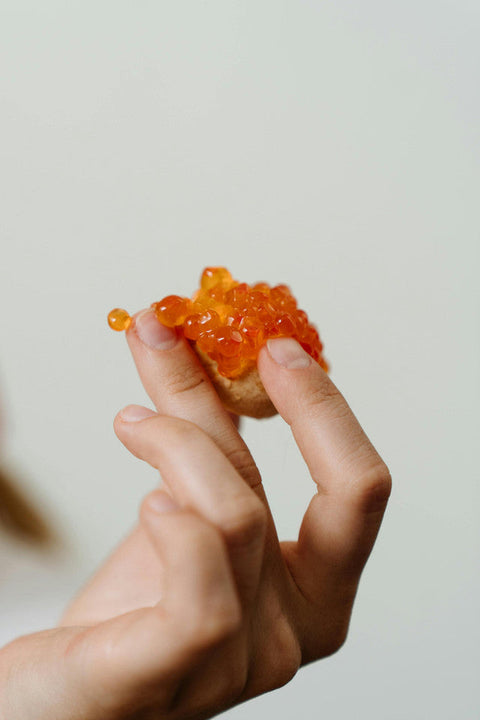The Art of Texture: Understanding the Sensation of Caviar
Caviar texture is often its most captivating characteristic—an experience that heralds quality long before flavor unfolds on the palate. Unlike taste, which can be described in terms of saltiness or umami, the texture of caviar delivers a multisensory experience that is both tactile and emotional, setting the stage for every memorable tasting.
Black Caviar: Creamy Elegance
Black caviars, such as Osetra, begin with a delicately firm structure, exuding refinement the moment you touch them. These eggs yield a refined resistance when gently pressed, yet once warmed by palate heat, they transform into a smooth, buttery texture. This transition—from firmness to velvety melt—is the hallmark of high-quality roe, familiar to connoisseurs as both a delight and a sign of proper handling.
Larger eggs from more mature sturgeon, like those in prized Royal or Imperial grade Osetra, may offer a subtle “pop.” Unlike the crisp burst of red caviar, these pops are gentle and elegant, signaling a well-preserved membrane and rich interior. As each egg dissolves, its creamy essence coats the mouth, paving the way for the flavors that follow. The membrane should dissolve easily as you press the caviar into your soft palate.
Red Caviar: Bold and Bursting
Red caviar, such as salmon roe, delivers a very different but equally compelling texture. These eggs are larger and firmer than their black counterparts, akin to gelatin or encapsulated flavor beads. Bite into one, and you’ll hear a satisfying “pop”, a testament to a sturdy membrane that releases a surge of briny, savory liquid.
This burst of flavor capsules is what makes red caviar an engaging and playful experience. Ideal for sushi rolls and smoked fish platters, red roe adds texture and theatrical flair—an explosion of taste and mouthfeel that is impossible to ignore. It is this distinctive “pop” that defines red caviar, making it a favorite among those seeking a dynamic sensory experience.
The Role of Species and Quality
While species destiny plays a key role in texture, there are other factors at play:
- Fish Health and Diet: Fish that are well-nourished and healthy produce eggs with firm, resilient membranes. Conversely, roe from stressed or unhealthy fish tends to be soft or watery.
- Processing: Immediately after harvest, eggs must be handled with precision—salted just enough, stirred gently, and kept at optimal temperature. Any deviation can compromise texture.
- Freshness and Storage: Even the best roe will deteriorate over time. Caviar should be consumed within its prime window: Malossol caviar stays firm and creamy when stored between 26–36°F and eaten within a few weeks. Prolonged refrigeration, freezing, or poor repackaging invite texture degradation—eggs can become overly soft or soggy.
- Handling: Use non-metal spoons and serve chilled in glass or mother-of-pearl bowls. This preserves texture integrity and protects from off-flavors.
Spotting High-Quality Texture
How can you confidently identify roe with exemplary texture? Here’s what to look for:
- Visual Inspection: Quality eggs glisten and remain discreet, not flattened or merged. They hold their shape and possess a subtle sheen.
- Gentle Touch: Even before tasting, you should sense a slight resistance through the bowl—an indication the membranes are intact.
- Taste Test: A well-textured black caviar will yield to the palate with grace, becoming creamy without losing cohesion. Red caviar, on the other hand, should deliver a clean, crisp pop followed by a silky release of briny juice.
- Aftertaste & Mouthfeel: Nothing should linger as undesirable texture. Poor quality roe leaves a slimy or mushy residue, whereas exceptional caviar leaves a balanced, pleasant finish on the palate.
Practice Makes Perfect
Understanding texture isn’t instantaneous—it is learned through experience. Sampling a variety of roe—from entry-level to premium—can enhance your sensitivity to differences. Begin with affordable American hybrid caviars, then progress to higher-grade Osetra, Kaluga, or Beluga hybrids. Likewise, explore different red roes—from delicate trout to robust sockeye salmon—to become adept at discerning texture nuances.
Take note of how freshness, handling, and curation influence texture. Compare well-stored tins to those kept too long. Use proper utensils and serving temperatures to preserve that perfect mouthfeel, and challenge yourself to identify key traits: Do the eggs remain separate? Do they pop cleanly? Do they melt with elegance?
Texture: The Foundation of Flavor
Ultimately, caviar texture is the canvas upon which flavor paints its masterpiece. No matter how exquisite the taste of caviar, without the right consistency, it can feel lackluster. Conversely, a superb texture primes the palate, making every nuance of flavor more vivid, resonant, and memorable.
In your next tasting, notice the texture foremost—it’s the language of caviar. And once you’ve mastered its lexicon, you’ll taste more than just salt and brine; you’ll taste excellence. Shop our selection today to experience premium caviar texture first-hand!



